A trip to Athens is like stepping into the pages of a book, where ancient classics and modern culture come together. Whether visiting for the first time or seeking new adventures in this city, our ultimate travel guide has got you covered. From exploring iconic landmarks and sampling authentic Greek cuisine to finding the perfect places to stay, we’ll take you through everything you need for a fantastic first trip to Athens. So grab your comfy shoes, and let’s delve into the heart of Greece’s capital.
Everything You Need to Know Before Your First Trip to Athens
1. Brief History of Athens
Athens dates back to the 3000 BC. During the Classical Period (480-323 BC), it became a prominent center for philosophy, art, and learning. Many famous philosophers like Socrates, Plato, and Aristotle lived and worked in Athens.
Under Cleisthenes, in 508-507 BC, the city established a political system called Athenian democracy. During the 5th century BC, under the statesman Pericles’ leadership, Athens enjoyed a golden age that saw the construction of remarkable monuments like the Parthenon. This era was also marked by conflicts such as the Peloponnesian War (431-404 BC) between Athens and Sparta.
By the 2nd century BC, Athens had lost its power and had been conquered by the Romans. The Roman period saw significant changes with new buildings but diminished autonomy for Athenians. In AD 529, Emperor Justinian closed down the city’s philosophical schools during the Byzantine era. Over centuries of occupation by various empires, such as the Byzantines and the Venetians, Athens experienced cultural exchanges but suffered damage from wars and pillaging.
The Greek War of Independence (1821-1832) led to Greece’s modernization and Athens being declared capital in 1834. Today, Athens symbolizes ancient achievements in art and thought while being a contemporary metropolis.
2. Best Time to Visit Athens
Spring and autumn are the best times to travel to Athens, particularly from April to June and September to November. The weather is mild during these seasons, and attractions have fewer tourists and crowds.
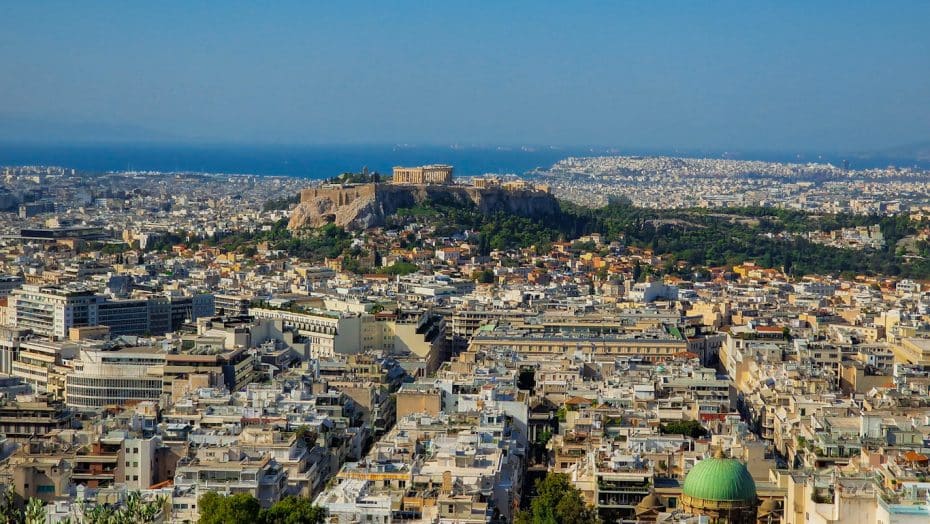
There are also several festivals throughout the year that you may want to attend in Athens. For instance, locals celebrate Apokries (Carnival) from January through February with colorful costumes and dances. Another event worth mentioning is the Athens International Film Festival (AIFF), which has been hosted annually in September by the Athens Film Society since 1995. This event presents international independent films while promoting them within Greece’s cinematic realm.
3. How to Get to Athens
Being one of the most visited destinations in Europe, there are many ways to reach Athens. The most common way is by plane, with direct flights to the city from other European countries like Spain, the UK, Italy, France, Germany, and Portugal. In addition, there are flights to Athens from the US and Canada. Athens International Airport Eleftherios Venizelos is approximately 34 kilometers east of the city center and is well-connected by public transport, including the metro.
You can also get to Athens by bus. The KTEL network of suburban buses connects Athens with most Greek towns and cities. The two main stations in Athens are the Kifisos KTEL station, northwest of the city center, and the Liossion KTEL station, north of the city center.
Sea travel is another option to reach Athens. There are a few long-distance cruises to Athens from the US, specifically Fort Lauderdale. Likewise, several cruises to the Greek islands make stops in Athens, including a few departing from Venice and Rome. Athens’ main port is Piraeus, one of the busiest in Europe, located about 12 kilometers southwest of the city center.
4. Where to Stay During a First Trip to Athens
Two areas stand out as the best neighborhoods to stay in Athens during a first visit: Plaka and Koukaki.

- Plaka. Located at the base of the Acropolis hill, Plaka is considered Athens’s oldest neighborhood. The district is home to preserved neoclassical architecture and narrow pedestrian streets that date back to ancient times. As a result, Plaka exudes an authentic atmosphere that makes it one of the coolest neighborhoods in Athens. Points of interest in the area include the Tower of the Winds, a first-century BC clocktower designed by Andronikos Kyrrhestes, and the Roman Agora, an ancient marketplace built in 11 BC.
- Koukaki. Primarily a residential area, Koukaki features well-maintained green spaces and early 20th-century Athenian houses that provide a quieter atmosphere than other central districts. Notable places within the neighborhood include the Museum of Contemporary Art EMST (inaugurated in 2016), which showcases Greek and international art exhibitions, and Filopappou Hill, which has panoramic views of Athens.
5. Must-see Attractions in Athens
- The Acropolis
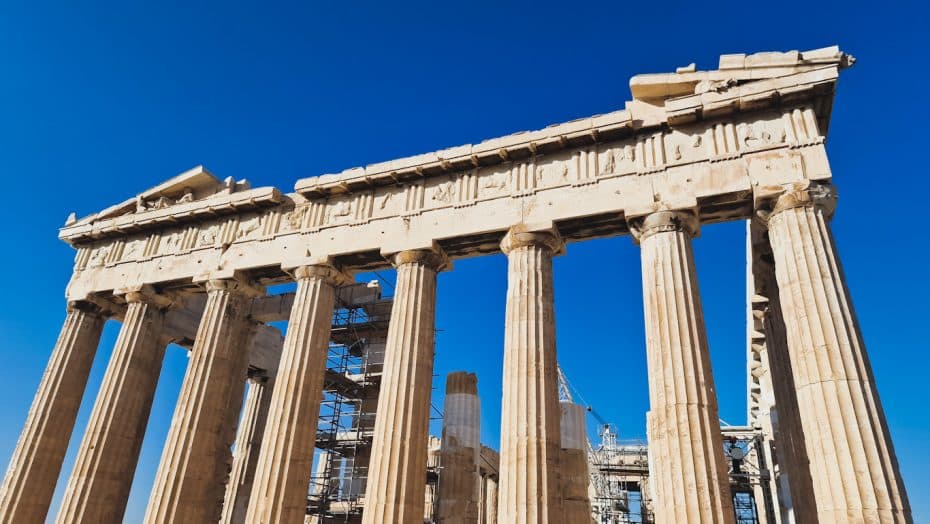
The Acropolis dates back to the 5th century BCE. This ancient citadel contains several well-preserved buildings, most notably the Parthenon, a temple dedicated to the goddess Athena.
Built during the Golden Age of Athens, under the leadership of Pericles, the Acropolis embodies this period’s high artistic and architectural achievements. So, visiting the Acropolis will allow you to appreciate its architecture and historical relevance. As a symbol of Athenian democracy, it represents the city’s growing influence throughout ancient Greece. Furthermore, its location atop a natural rocky outcrop offers breathtaking panoramic views of Athens.
To avoid queues, you should buy tickets for the Acropolis online beforehand. Try to get to the Acropolis early, too. Otherwise, the crowds may be overwhelming, especially in the summer. You could also book a guided tour of the Acropolis and Parthenon.
- The Ancient Agora
The Ancient Agora, an essential attraction during a first trip to Athens, is northwest of the Acropolis. This public space was the center of ancient Athenian life, dating back to the 6th century BCE. The area was crucial in social, political, and economic activities.
The Stoa of Attalos and the Temple of Hephaestus are notable structures within the Agora. The Stoa of Attalos, reconstructed in the 1950s to house the Museum of the Ancient Agora, is a prime example of Hellenistic architecture. On the other hand, the Temple of Hephaestus, built in 449 BCE by architect Ictinos, remains one of Greece’s best-preserved ancient temples.
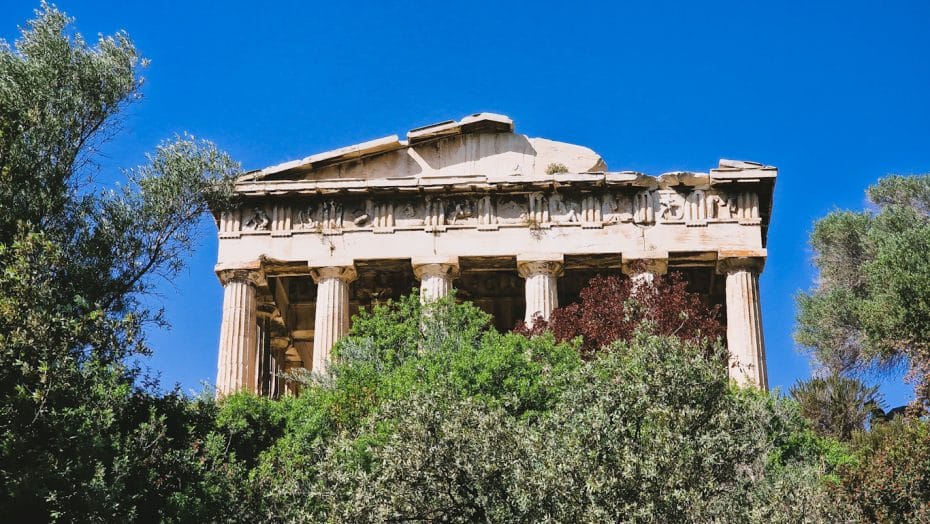
Prominent historical figures frequented this location, including Socrates, who taught philosophy within its walls.
- National Archaeological Museum
Another crucial attraction is the National Archaeological Museum, which houses numerous artifacts from prehistoric times to late antiquity. This museum contains objects recovered from multiple regions within Greece, allowing visitors to delve into Greek history.
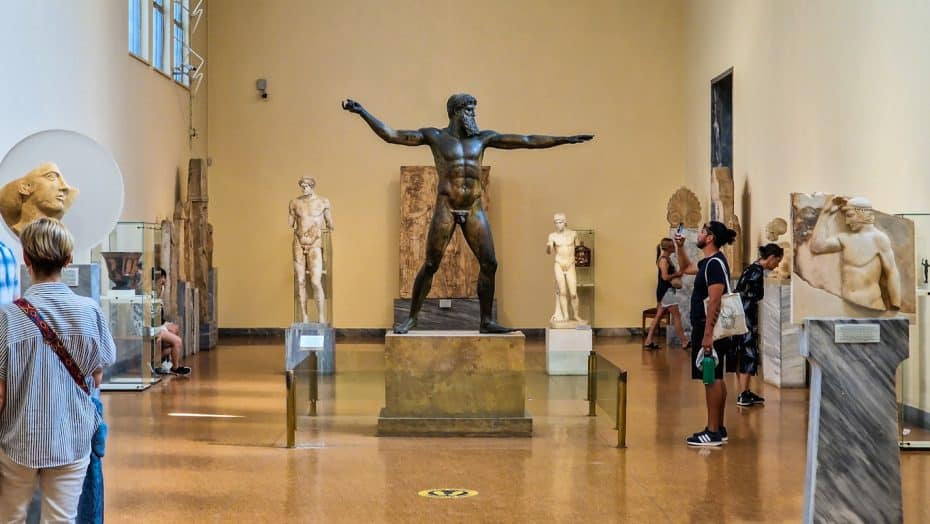
6. Where to Shop in Athens
Plaka is well-known for its shopping scene. Its narrow streets are lined with small boutiques and souvenir shops that showcase traditional Greek products and antiques.

Another notable shopping destination in Athens is Monastiraki, which lies west of Plaka. Home to numerous antiquities stores, Monastiraki also hosts a flea market every Sunday where locals sell vintage clothes, handicrafts, and traditional Greek products.
7. Where to Eat in Athens
Plaka hosts excellent restaurants for first-timers to Athens. One of its well-known restaurants, To Kafeneio, is on Epicharmou 1 and was founded in 1887. It specializes in traditional Greek cuisine, with dishes such as moussaka and souvlaki being highly recommended by frequent patrons.
Another area in Athens for exceptional gastronomy is Psiri, north of Monastiraki Square. This former industrial neighborhood has evolved into a bustling hub for dining, nightlife, and street art since the 1990s.

Finally, Gazi is an area that should be considered when looking for places to eat in Athens. Located west of the city center, around former gasworks which now houses the Technopolis cultural venue, Gazi was transformed during the preparations for the 2004 Olympic Games. These days, the neighborhood features houses and many restaurants along pedestrianized streets.
8. Best nightlife in Athens
One of the best areas for nightlife in Athens is Exarcheia, located northeast of Omonia Square near the Panepistimio metro station. This neighborhood stands out for its alternative vibe, with bars that showcase local musicians in intimate settings. The area is also renowned for its many bookstores, independent film screenings, and community events.
Gazi is another neighborhood in Athens known for its entertainment and nightlife. This area is home to music venues such as Gazarte and Votanikos, which offer live performances from various genres. Smaller bars like Mamacas contribute to the artsy atmosphere of the area with their contemporary design and eclectic music selection.
9. How to Move Around Athens
The public transportation system in Athens includes the Athens Metro. This metro system has operated since 1869 as a steam-powered railway and eventually transitioned into an electric railway in 1904. Today, it comprises three lines with 64 stations that span a combined length of 84.5 kilometers.
In addition to the metro, Athens has an extensive network of buses and trolleybuses managed by OASA (Athens Urban Transport Organization). These bus lines operate on designated routes across the city.
Another significant mode of transportation found within Athens is the tram system. The modern tram network began operating in 2004, just in time for the Olympic Games hosted by Athens that year. The tram connects important coastal suburbs to the city center, covering approximately 27 kilometers.
As in all major European cities, many taxi services and apps serve Athens.
10. Day trips from Athens
- Delphi Archaeological Site
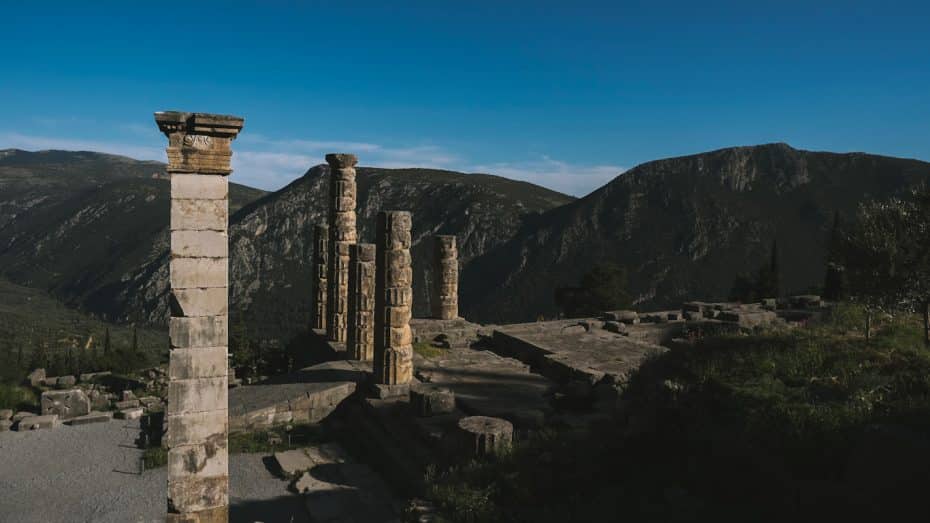
Delphi, a UNESCO World Heritage Site, is three hours northwest of Athens. The site was well-known in Greek mythology as the ancient world’s revered center and the residence of the oracle Pythia.
Historically, Pythia guided countless seekers of wisdom, including prominent rulers like Croesus and Alexander the Great. Excavations at the site began in 1892 by French archaeologist Théophile Homolle. The structures discovered include the Temple of Apollo, the Treasury of the Athenians, and Tholos.
You can take a bus from Athens Liosion station to Delphi.
- Ancient Corinth
Ancient Corinth is approximately 85 kilometers west of Athens and is a significant archaeological spot in Greece. Founded in the 10th century BCE, Corinth became a prominent city-state during the Classical period due to its strategic location near essential trade routes.
In Ancient Corinth, you can explore ruins such as Peirene Fountain, Acrocorinth (a rocky hilltop fortress), and the Sanctuaries of Aphrodite.
To get to Ancient Corinth, you must take a bus from Athens Kifissos station to Corinth City, which takes about an hour. Once in Corinth City, you can take another bus to Ancient Corinth and be there in 20 minutes.






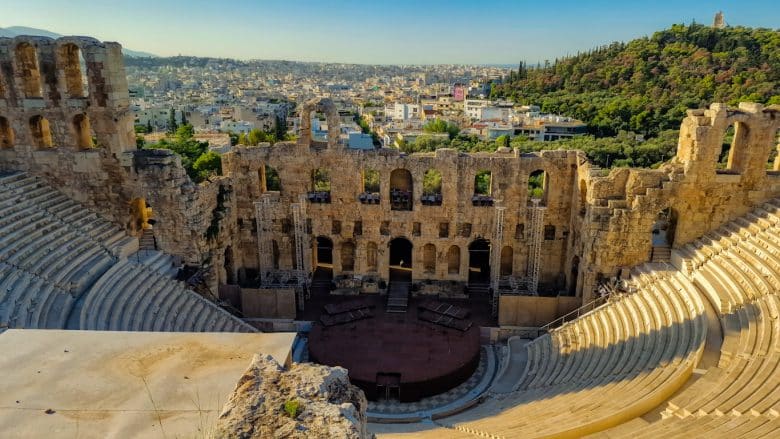





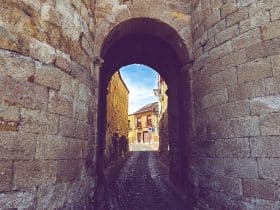














Leave a Reply
View Comments